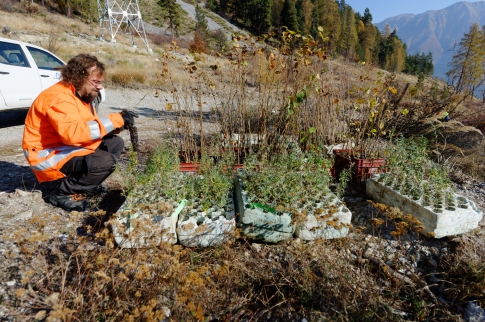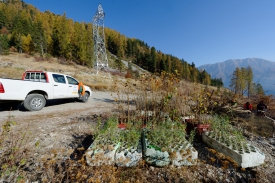News
2017-11-06
Kick-off for plantations in Haute-Durance
Since the start of the LIFE project, the Haute Durance site, one of the 7 pilot sites in France, has been the subject of numerous meetings. These have made it possible to integrate biodiversity as well as possible upstream of a vast renovation project of electrical infrastructures within the perimeter of the Ecrins National Park.
Our team has just participated in the preparations necessary for the plantation of edges around the lake of Serre-Ponçon.

Description
Three edge plantation zones have been identified on the properties of the communes of Saint Apollinaire, Savines-le-Lac and Puy-Sanières, as well as in a private property. Nearly 20,000 plants will be installed on a total area of about 10 ha : around 10,000 Common sea buckthorns (Hippophae rhamnoides), 5,000 Hazel trees (Corylus avellana), 2,500 Field maples (Acer campestre), 800 Wild apple trees (Malus sylvestris), 200 Sorb trees (Sorbus domestica) and 200 Common whitebeam (Sorbus aria).
Preliminary to planting
Edges plantations require to follow some steps :
- The first step is the production of plants, ideally of local origin. In this logic, a harvest was carried out in 2015 by members of the LIFE team to propose seeds harvested locally to nurseries in the region. (see News http://www.life-elia.eu/en/News/Fruit-harvests-in-Haute-Durance-for-a-plantation-on-site-in-2017-F-)
After extraction, storage and breaking of dormancy, the seeds concerned were cultivated in Robin nurseries, to provide part of the plants needed for the plantations. In this case, bucket plants will be used.

- The second step is to ensure the exact positioning of the edges to be planted on the areas concerned, to facilitate the work of the planters. In consultation with RTE, the communes, the ONF, the Ecomed office, etc., the zones have been definitively marked out to ensure the continuity of the safety corridor with the surrounding forest areas, but above all to integrate them into the landscape.
- The third step is the planting itself. It is an association of social enterprises that will carry out all the planting. The association " LRS " Lac, rivières et sentiers (http://www.environnement-amenagement.fr), les Environneurs (http://www.lesenvironneurs.fr) and Environnement et solidarité (http://www.cpie-hautedurance.org), approved by CPIE Haute Durance, have joined forces to take up the challenge of this project.
As part of social reintegration through environmental activities, more than 30 people will take turns to ensure the success of our plantations.
The planting conditions are particularly difficult on this site in the Haute Durance: very rocky soil, no land. Planters are forced to dig with a pickaxe and to bring in soil to increase the chances of regrowth of the plants.

On site
The first task of our team was to mark out the work areas in order to facilitate the action of the planting teams. A series of constraints are identified under and around the network: do not plant directly above drivers or in sensitive natural areas, respect an area of 400 m2 around the pylon bases, leave 1 meter along the access tracks to the building sites,... The picketing of these zones was carried out on the 10 ha to simplify as much as possible the arduous work of plantation in mountain environment.

Information and consultation with companies is also necessary to guarantee quality work.
The LIFE team on the spot facilitated the launching of the plantation sites before the periods of freeze and snowfall.
Conclusion
The species planted will enrich the surrounding forest areas with woody, flowering or fruit species such as hazel, common sea buckthorn, domestic mountain ash or forest apple. Their blooms will offer a nice landscape appreciated by hikers in the years to come but will also fully benefit the animal species frequenting the open corridors.




